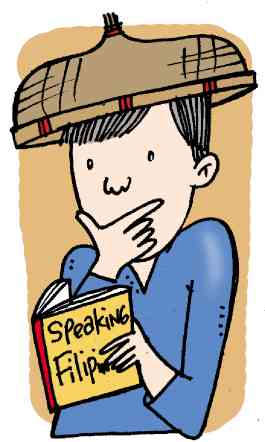Filipino is no longer Tagalog
Many detractors of Filipino, the national language, insist that it has remained the old Tagalog that was proclaimed as the basis for the development of the national language by President Manuel L. Quezon in 1937.
“No longer so,” counters Virgilio S. Almario, chair of the Komisyon sa Wikang Filipino (KWF), the government agency for language. “If you go to the regions, you will hear a different ‘Filipino,’ different in accent as well as in vocabulary,” Almario says.
The KWF chair and some of his staff have traveled, since 2013, almost weekly all over the archipelago spreading the good news of the national language through seminars and workshops called “Uswag: Dangal ng Filipino.”
The series of seminars and workshops teaches teachers, government workers, students and ordinary people the newly reformed Ortograpiyang Pambansa (National Orthography manual), Manwal sa Masinop na Pagsulat (a style guide on writing standards) and Korespondensiya Opisyal (government correspondence workshop).
“Our task is to propagate, develop and enrich Filipino by way of entries from the native languages, not only in words but in the concepts, experiences, knowledge and wisdom that are contained in the native words,” Almario explains.
Living language
This disproves another misconception that the KWF or the national language is out to kill the native and regional languages. “Too far from the truth,” Almario says. “Filipino is a living language,” he says, quoting from the official definition of Filipino as promulgated in KWF Board Resolution No. 13-39 (Series of 2013).
“As a living language,” Almario quotes further, “[Filipino] is rapidly being enriched through daily use and through other manners of usage in different places and situations and developed in different levels of research and academic discourse but in an integrative process that gives importance to entries bearing the creative qualities and necessary knowledge from the country’s native languages.”
During the 1950s, the language was still referred to as “Pilipino,” in accordance with the 20-letter Tagalog abakada, which has no letter F or V and other important letters such as those used in the Filipinos’ Spanish surnames (Fernandez, Valencia, etc.).
Abakada was the alphabet adopted by Lope K. Santos in his Balarila, or the Tagalog grammar then taught in schools, which was based on Jose P. Rizal’s study titled “Estudios sobre la Lengua Tagala,” which he wrote while on exile in Dapitan and published in the periodical La Patria in 1898.
Rizal became the first language and orthographic reformist when he added the vowels E and O to the three-vowel, 17-sound baybayin, or native syllabary, to accommodate the corresponding vowels in words borrowed from Spanish. This early, the abakada was no longer “pure” Tagalog.
More extensive
The 1987 Constitution further changed all that, according to Almario. When the Constitution called the language “Filipino,” the process entailed a more extensive orthographic reform and the adding of eight letters to the Tagalog/Pilipino abakada for it to become more inclusive of the sounds occurring in the Philippines’ other native languages.
“That is how the Pilipino abakada became the Filipino alpabeto,” Almario explains.
The word “Ifugao” alone, referring to the province and one of the Cordillera ethnic groups, would have been practically “illegitimate” if the letter F did not exist in the Filipino alphabet.
“That’s why the Filipino language is no longer Tagalog,” Almario says. “Apart from Ifugao we have Ivatan, the name of the people of Batanes, who have words like falua (the sturdy boat plying the islands of Batan, Sabtang and others), vakul (the Ivatan reed headdress).”
“Imagine if we don’t have the letters C, F, J, Ñ, Q, V, X, Z,” Almario says. “How can the Filipino language take in new word entries from the native languages, much less write, such words as zigattu or east in Ibanag, safot or spider web in Ibaloy, falendag or leaf flute in Tiruray, jambanan or flowering plants in Tausug, masjid or mosque in Tausug and Mëranaw (the latter with the schwa sound) and vuyu or falling star in Ibanag?”
How can we borrow scientific or technical words like oxygen, xenon, trajectory, etc., without those letters?
Even going further back, Tagalog did not have a word for freedom in the 19th century. But Rizal remembered that Marcelo H. del Pilar used the word laya in one of the latter’s essays. He did not know where Del Pilar got the word but Rizal used kalayaan in his translation of the word freiheit in the story of William Tell.
Thus a new word enriched the language just when the nation needed a word for its intense aspiration and sentiment to be free from the colonial yoke.
We did not have a word for justice but Visayan has the word tarong and Bicol has tadong for being upright and righteous, which gave Filipino that important word, katarungan.
“It is only just and righteous that the national language includes all the sounds and is enriched by words from the native languages,” Almario concludes.
